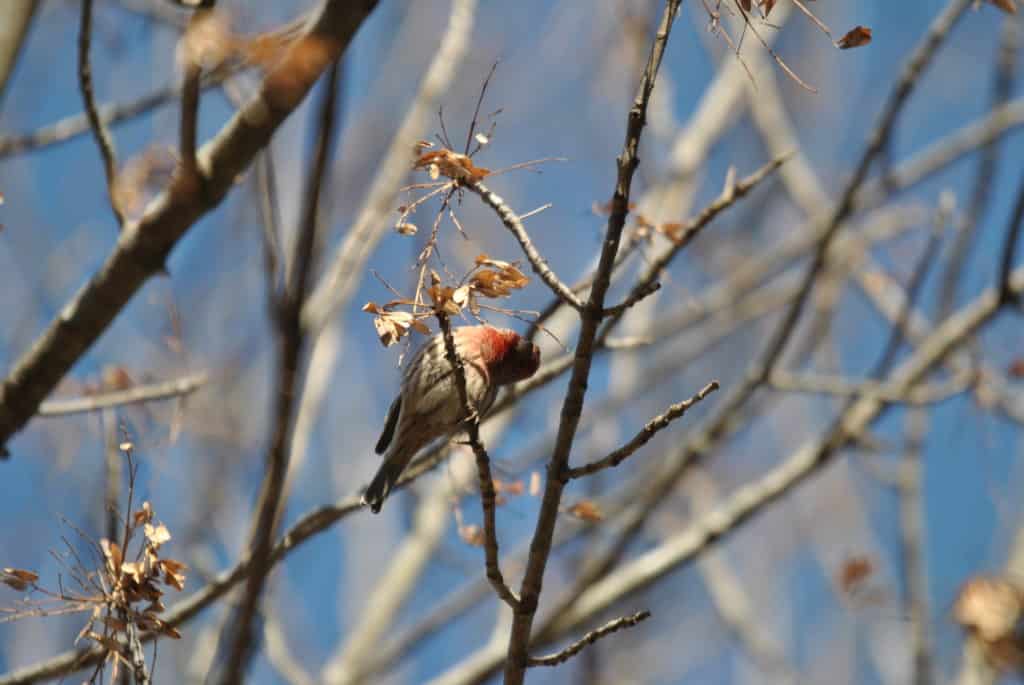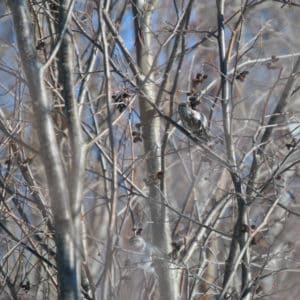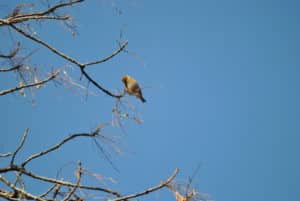
By planting or encouraging native woody plants in your yard, you can attract these winter visitors.
The arrival of “winter finches” is one of the most anticipated events in winter birding. Several species, including Evening Grosbeaks, Pine Siskins, and Common Redpolls, move southward in winter in search of food. These movements are known as “irruptions”, partly to distinguish them from the normal migratory and seasonal movements of other species. On a large scale, these irruptions are in response to the absence of mast crops in their species’ normal ranges, and the presence of mast crops farther south.

Mast crops refer to the seed productions of woody plants, especially in forest systems. For a variety of reasons (that are not well understood), these crops are produced by species in larger amounts in cycles of two or more years. These cycles vary by species and by region, such that in a given area in a given year, a few species will have mast crops and the rest will not. When the food source(s) of one of these finch species is not in a mast year in their normal range, it can cause them to move south into areas where their preferred plant foods are in a mast year (or at least more abundant).
These movements are forecasted and documented by the Finch Research Network. Its yearly Winter Finch Forecast predicts irruptive movements based on surveys of mast crops throughout North America. You’ll notice that for each species of finch, it mentions the presence or absence of mast crops for a few species of trees. By planting or encouraging these native woody plants in your yard, you can attract these winter visitors.
There are a couple of considerations when planting for winter finches: like any other animals in winter, these birds need food, water, and shelter. Most of these finches will visit feeding stations, and there are a number of recommendations for seed types by species in the Winter Finch Forecast, as well as this article from Madison Audubon in Wisconsin. Briefly, smaller finches prefer thistle and Nyjer seed, while larger finches prefer sunflower seeds, safflower seeds, and cracked corn.

After providing feeding stations, including native plants in your yard is the easiest and most affordable way to attract winter finches to your yard. These species feed primarily on seeds and fruit during the winter, and there are a number of native plant species that can provide these food sources. Finches will forage seeds from a wide variety of plants, including forbs (herbs), shrubs, and trees. Among the forbs, those in the aster family (Asteraceae) are most important. Native species of goldenrod (Solidago spp.), aster (Symphyotrichum spp.), sunflower (Helianthus spp.), thistle (Cirsium spp.), and coneflower (Rudbeckia spp. and Echinacea spp.) all produce an abundance of small seeds that are relished by finches. Most of these species thrive in meadows or forest edges, and are easy to grow in most yards. Goldenrods and asters are our most important herbaceous keystone species, and provide numerous benefits to multiple species throughout the year. The evening-primroses (Oenothera spp.) also produce an abundance of small seeds for finches, and can grow in the most depleted soils.
Finches also forage seeds from a number of different trees and shrubs. Evening Grosbeaks are especially fond of Box Elder (Acer negundo) and ash seeds. Redpolls feed primarily on birch and alder seeds during the winter. The most significant deciduous species are maples (Acer spp.), ashes (Fraxinus spp.), elms (Ulmus spp.), alders (Alnus spp.), and birches (Betula spp.). These species are important because they produce seeds late in the season and hold them throughout the winter. Here in southern Maine, this year, the most abundant seeds are on White Ash (Fraxinus americana) and Gray Alder (Alnus incana).
Most of our native coniferous species can also provide seeds for finches in winter. These include pines (Pinus spp.), spruces (Picea spp.), firs (Abies spp.), cedars and junipers (Juniperus spp. and Thuja spp.), hemlock (Tsuga canadensis), and tamarack (Larix laricina). The mast crops of spruces are especially important to the irruptive movements of crossbills. These coniferous species also provide cover for finches and many other species in the cold of winter. In the absence of other foliage, conifers are some of the best places for songbirds to hide from predators, feed safely, and roost inconspicuously.
Fruits are the other critical source of food for finches in the winter. Our native species that hold their fruit through the winter include hollies like Winterberry (Ilex spp.), hawthorns (Crataegus spp.), bayberries (Morella spp.), and mountain ash (Sorbus spp.). Crabapples (Malus spp.) are not native to Maine, though there are species native to the Northeast, but they behave more like native species than other berry sources like Multiflora Rose and Asiatic Bittersweet. Crabapple cultivars like ‘Donald Wyman’ and ‘Prairifire’ are already widely planted and hold small fruits throughout the winter that will attract species like Pine Grosbeaks and waxwings. The native species should be your first choice in the landscape, for the wide variety of benefits they provide to multiple species, followed by regionally native species of crabapples, hawthorns, and hollies.
Invasive species, like Multiflora Rose and Asiatic Bittersweet, should be removed whenever possible, since they provide less benefits to native species and outcompete native plants for space and resources. These finch species will unfortunately spread the seeds of invasives by eating and excreting them. Find these invasives by their persistent fruits this winter and remove as many as possible from your landscape.
Now is the perfect time to adjust your landscaping to attract winter finches for years to come. Invasives can be cut back to prevent their spread and create more space for native species that provide more benefits to more species. Native species of seed- and fruit-bearing plants, like goldenrods and asters, can be directly seeded into landscapes or started in pots or flats for spring transplanting. Perennial species, like Winterberry or Gray Alder, can be transplanted as long as the ground is not frozen. Join a program or class to learn more about native plants; learn more about many of these plants on our Maine Native Plant Finder website (mainenativeplants.org); and purchase plants from Maine Audubon’s Native Plant Sale in the summer. These changes will keep attracting finches to your yard for many winters to come.
